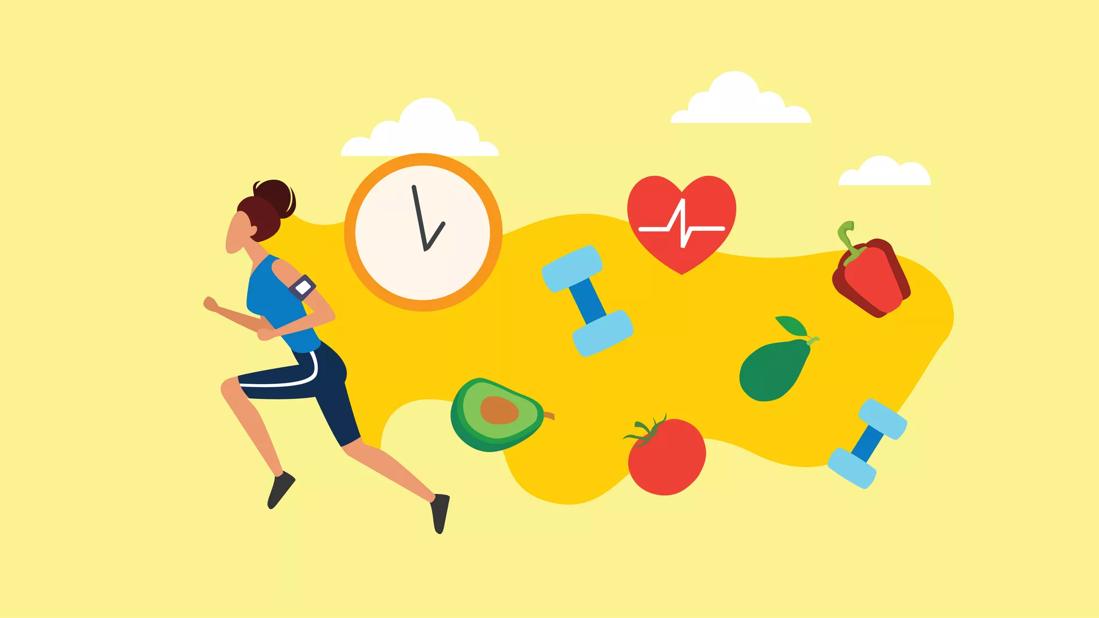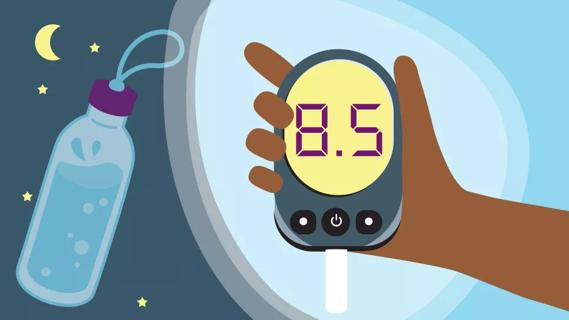It’s best to exercise before or after your fast, instead of during it

The best time to exercise is always when you have a little bit of food and water in your body to fuel your system — but how can you do that if you’re fasting?
Advertisement
Cleveland Clinic is a non-profit academic medical center. Advertising on our site helps support our mission. We do not endorse non-Cleveland Clinic products or services. Policy
Athletic trainer Jennifer Dix, ATC, says there are ways to safely work out during a fast, whether you’re doing it for religious or health reasons. But you can’t treat a fast like it’s any other day, especially when it comes to physical activity.
“When you’re physically active while fasting, you have a much higher risk of dehydration and heat illness,” she says. “It’s something to be very cautious about.”
It may be called a “fast,” but when you can’t have any food or water, it’s smart (and healthy) to take things slow.
“Physiologically speaking, the best and safest time to exercise is when you have the most hydration in your body,” Dix says.
During times when you can’t replenish water and nutrients, it’s best to preserve your limited energy. That means it’s best to schedule your workout before your fast begins or after it ends.
In figuring out whether it’s OK for you to exercise, the details of your fast make all the difference. Let’s break them down, shall we?
Intermittent fasting is when you alternate between set time periods of eating and fasting. This type of fasting offers you more leeway to safely work out than religious fasts typically do.
“If you’re doing intermittent fasting for health reasons or weight loss, you can tailor your workout schedule to line up with your periods of eating and fasting in a safe and healthy way,” Dix says.
Advertisement
If you’re doing a religious fast, the rules are already written for you — but those rules vary depending on each faith tradition. And again, the details make all the difference in figuring out how to safely exercise while fasting.
Partial fasts involve eating less or abstaining from certain types of food. For example, on certain days associated with the lunar calendar, many Buddhists stop eating after their midday meal.
“Partial fasts are basically a type of intermittent fasting,” Dix says, “so it’s best to schedule your workouts during the times when you’re not fasting. This way, you’re able to eat and hydrate before and after physical activity.”
Things get trickier, though, when it comes to complete fasts — the kind where you abstain from all food and drink for a set timeframe.
Some complete fasts allow for drinking water, while others don’t. Here are some examples of the many types of religious complete fasts:
Because there’s so little research on the topic, Dix cautions that many of the tips and guidance on physical activity while fasting — including her own — come from anecdotal experiences from athletes, coaches, nutritionists and others in the field.
She shares exercise tips for times when you’re fasting. But keep in mind that all of these tips vary depending on the rules and guidelines of the specific type of fast you’re doing.
If possible, don’t exercise in the middle of your fast day. Instead, fit in your workout before your fast begins, or put it off until after your fast has ended.
“If you exercise before your fast starts, you’re able to work out and recover at a time when you’re still allowed to hydrate before, during and immediately afterward,” Dix says. The same is true of exercising after your fast ends, so long as you ease out of your fast the right way and hydrate before you hit the gym. (More on all of that in a moment!)
If you play a team sport, like if you’re a high school or college athlete, you likely don’t have a say in your training schedule — but that doesn’t necessarily mean you have to skip your workout while you’re fasting, Dix says. That leads us to our next point…
Advertisement
If you’re doing a sunrise-to-sunset fast, like during Ramadan, it’s especially important that you don’t skip breakfast. And if you have a midday workout that can’t be rescheduled, like football practice, be sure to eat some extra protein in the morning before your fast begins.
“I recommend adding a protein shake to breakfast before your fast begins,” Dix says. “When you can’t eat during the day, it can be difficult to get in all the protein your body needs, especially for physical activity, so a shake can help supplement.”
What if you’re participating in a complete fast that doesn’t allow you to eat breakfast at the start of the day? In these cases, Dix says that it’s safest to avoid physical activity until you can break your fast and properly refuel.
Hydration is a key factor in working out, including how well you perform and how quickly you recover. When you can’t drink water during a fast, you risk health issues.
“There are risks to exercising when you can’t hydrate and don’t have any fuel in your system,” Dix warns. “You’ve got to be cautious and monitor yourself for dehydration issues.” Symptoms of dehydration include:
Advertisement
“To avoid these issues, be sure to focus on hydration during the times when you can eat and drink,” Dix advises. Water is the go-to way to do it, but certain fruits and veggies can help you hydrate, too. And it’s a good idea to skip that cup of coffee before a fast, as caffeine can contribute to dehydration.
When you’re exercising during a fast, your goal should be to get in a decent workout, not to bust through all your personal records for miles run or amount of weight lifted.
“Focus on the quality of what you’re doing, not the quantity,” Dix says. “If that last mile just isn’t feeling and you’re starting to stutter-step, just skip it.”
And if you’re doing a multiday fast, like during Ramadan, give your body some time to get used to its new eating schedule.
“It takes some time to adapt,” Dix notes.
Sweating helps your body control its temperature — and that sweat needs someplace to go. “Our bodies need sweat to dry off in order to cool us down,” Dix explains. Here’s how to cool off quickly.
Advertisement
We’ve already talked about how to prevent dehydration and the warning signs to look for, but there are other risks of fasting while exercising, too.
When it’s hot out, heat illnesses are common — and you’re at higher risk for them when you’re not well-hydrated. They include:
Keep an eye on how you’re feeling and heed your body’s warnings and requests.
“If you notice that you're slowing down, getting bad reps or feeling clumsy, it’s really important to back off of your workout,” Dix stresses. “Dehydration- and heat-related illnesses can escalate very quickly.”
If you’re planning to exercise after your fast has finished, don’t dig into heavy foods right away.
“Start hydrating and get a little bit of food in your body,” Dix advises. “You want to start giving yourself fuel without filling yourself up.”
These tips will help you make choices that will get your body get back up to speed, both literally and figuratively:
If you have a child who’s an athlete and is going to be doing an ongoing fast (like during Ramadan), Dix recommends letting their coaching staff ahead of time. Kids — even teens — don’t always have the self-awareness to know their limits or recognize when they’re starting to have issues.
“Make sure their coaches and phys ed teachers know they’re going to be fasting and can’t hydrate during that time,” Dix says. “This helps get another set of eyes on them during times of physical activity, from a health and safety perspective.”
Before you begin a fast, it’s always best to touch base with a healthcare provider to make sure it’s OK for you. Fasting isn’t safe for people with certain health conditions, and exercising while fasting can quickly lead to health problems in people who are already at high risk.
If you’re told that you shouldn’t fast, you might feel some guilt or sadness about not being able to take part in this religious ritual. Talk to a religious leader you trust, like a member of the clergy, to ask what they recommend instead, so you can participate in your community’s customs without risking your health.
Learn more about our editorial process.
Advertisement

Planning ahead, checking in with your care team and being vigilant about blood sugar monitoring can help ensure a safe fast

Plan ahead by hydrating, cutting back on sugar and managing medications

Fasting can significantly impact your hormones — proceed with caution

This short-term diet is for those who want to lose a significant amount of weight quickly

An expert breaks down how and why people try it

A cardiologist's perspective on pros and cons of fasting

'Early time-restricted feeding' can produce health + weight-loss benefits

Losing belly fat can reduce your risk for chronic health conditions — try focusing on a diet high in lean protein, exercising regularly, reducing stress and getting quality ZZZs

Type 2 diabetes isn’t inevitable with these dietary changes

Applying a hot or cold compress can help with pain